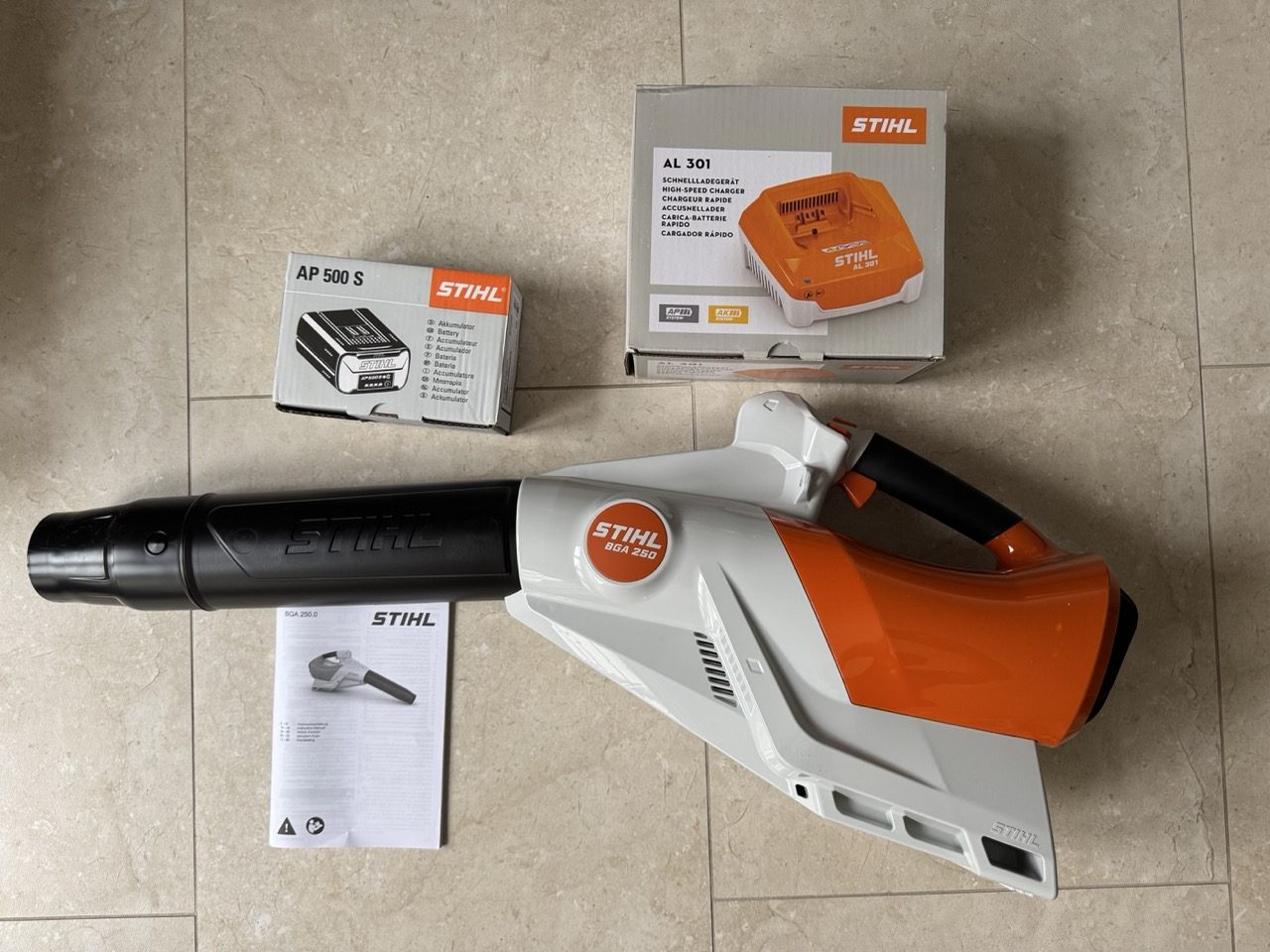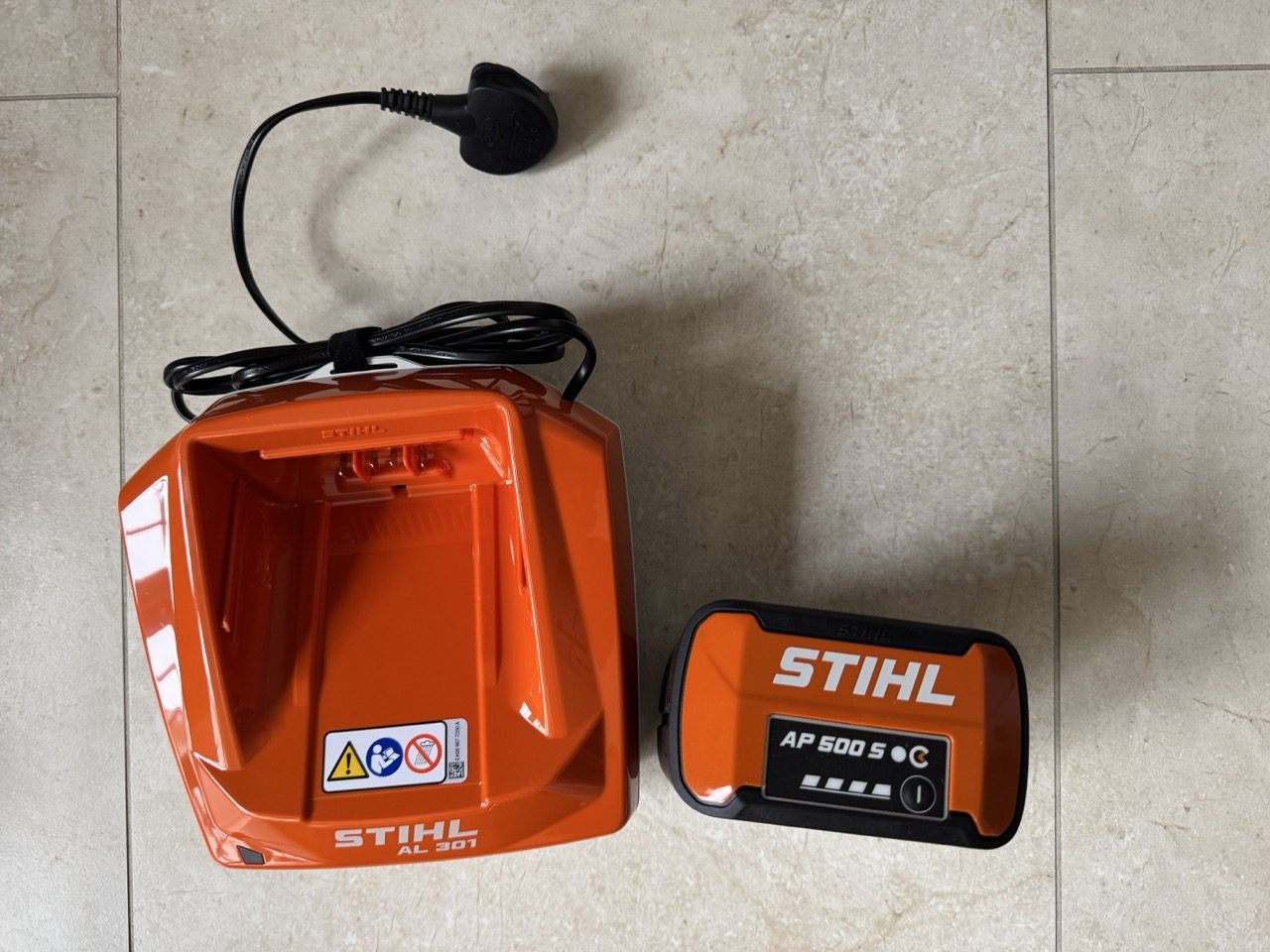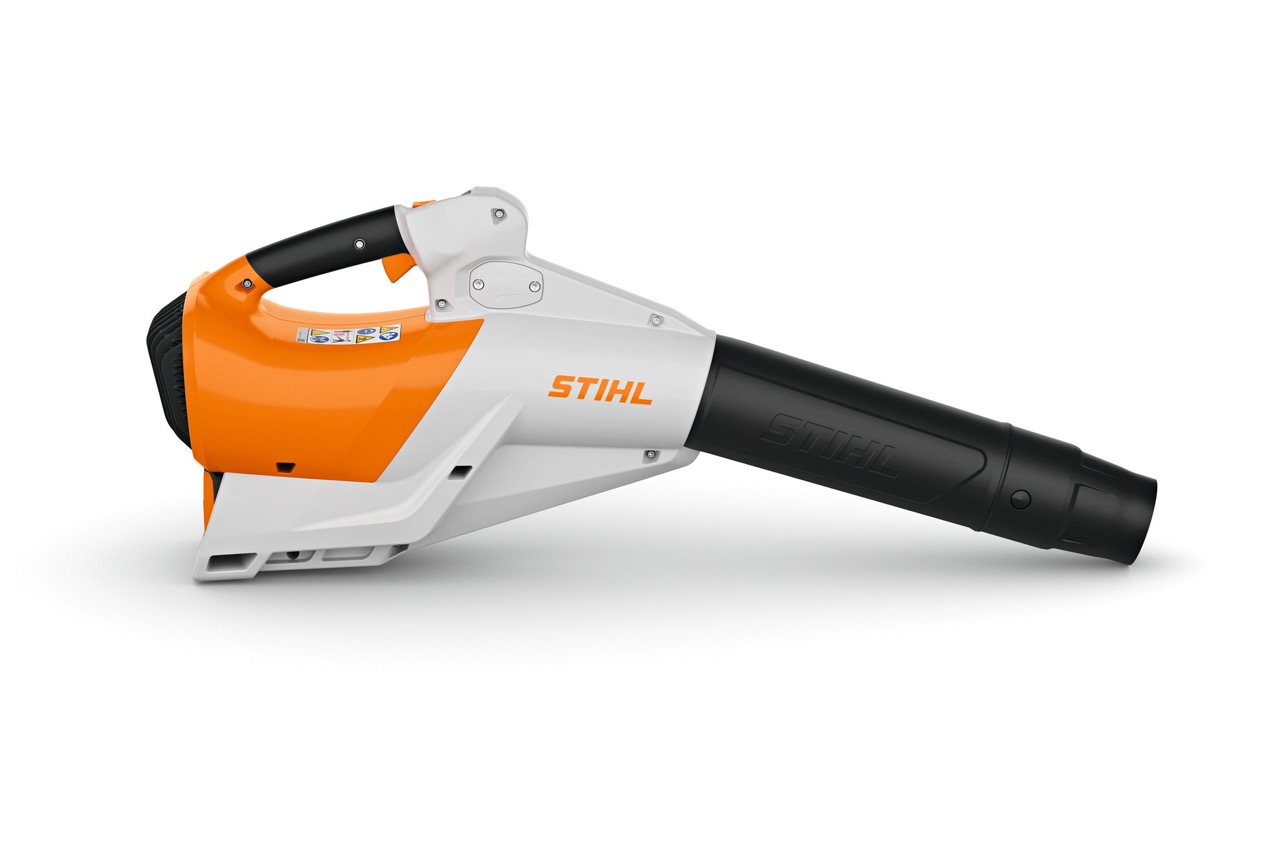Got a lot of leaves falling in your garden? Tried cordless leaf blowers and found they don’t quite cut the mustard? Let’s go in-depth as we review the BGA 250 from STIHL.
First, let’s look at the all-important specs and features of the blower. Use the table of contents below to jump to various sections if you prefer.
Key Specifications & Features
- The BGA 250 is part of the STIHL AP (battery) system: 36 V rated voltage
- According to STIHL, it delivers a maximum blowing force of 26 Newtons, which the manufacturer states makes it “the most powerful handheld leaf blower from STIHL to date”
- Air velocity: The BGA 250 gives max air velocity with the round nozzle of 85 m/s
- Weight: approx. 2.7 kg (tool only, no battery)
- Noise/comfort: It is stated to work quietly enough in certain settings that ear-defenders may not be strictly required
- Ergonomics: Balanced battery placement beneath the impeller/handle, angled blower tube to reduce wrist fatigue
- Controls & adaptability: Variable speed trigger, boost mode, cruise control for longer jobs, compatibility with STIHL’s Smart Connector 2A for data logging/fleet use
- Runtime with different batteries (important!). For example with the AP 500 S battery: up to ~48 minutes on “level 1” ; boost mode up to ~14 minutes.

Performance in Use
Power & Blowing Ability
The BGA 250 is clearly a high-end handheld blower. With 26 N blowing force, it is strong enough for challenging jobs. This includes the usual suspects of wet leaves, compacted debris, driveways, patios.
The high airflow/velocity figure suggests it will feel much more capable than typical domestic blowers – and in practice, it really does. The emphasis is more on professional clearing jobs and high manoeuvrability. The BGA 250 has some proper oomph.
To get a well-rounded view on it, I also browsed specialist forums, and in user comparisons it comes out favourably when compared to earlier models (such as the BGA 86). One user commented:
“On paper, the BGA250 has a lot going for it—better power, decent battery life, and a more ergonomic design.” Source: Reddit
…and it’s also lighter than the BGA 86 with much more power. See a bonus comparison with another brand of leaf blower at the end of this review).
Battery Runtime & Compatibility
Using the AP 500 S battery (which is the largest capacity in the AP System), you’re looking at up to ~48 minutes on the lowest power setting according to the spec sheet. Real-world runtime will depend heavily on power level, debris type, ambient conditions.

The major benefit is that STIHL emphasises “constant power output” until the battery is essentially empty (so you don’t get a drop-off in power part-way through). It’s a really good feauture.
If you use higher power/boost mode (for heavy wet leaf loads), runtime drops significantly (e.g., ~14 minutes listed for boost). That means for large-scale clearing you may well need a second battery or plan breaks between runs. I suggest, if you do get one of these, to start with the single battery and see if it gives you enough time per single run.
Ergonomics & Comfort
At 2.7 kg (tool only) the blower is reasonably light for a professional handheld. With the battery the weight will go up (depending on battery size/capacity). The balanced design (battery under handle) helps to avoid tipping and wrist strain.
It’s a smart design and it became obvious when using that the angle of the tube and handle make it pretty comfortable to hold even when on maximum power.
Cruise control function is a nice touch for longer jobs (locking throttle). Variable speed allows you to tailor airflow to the task. This makes it good for smaller jobs where full power isn’t needed.
Noise & Practicality
The quieter operation compared to petrol blowers is a meaningful advantage. This is especially important if you live in a residential area or have noise restrictions. Though you’ll still need to respect local regulations/consider PPE. Sound pressure level ~84 dB(A) tool only; 59 dB(A) at 15 m distance with round nozzle.
Durability & Build Quality
Being a STIHL tool, build quality is generally very good. Importantly, it’s weather resistant (IPX4 splash-protection rating for battery electronics) which means it’s more tolerant of damp/wet conditions.
I must admit that I really do like German design and build quality as a general rule, but this hasn’t made me biased for this review. Being completely objective, the product is light yet feels sturdy.
Pros & What Works Well
- High blowing force (26 N) and strong airflow/velocity make this well suited for serious debris clearing, not just light garden jobs.
- Excellent ergonomics: lightweight tool (for its class), well balanced, angled tube reduces wrist fatigue.
- Battery system: The use of the AP System means you can use other AP batteries if you already own them; high-capacity battery like AP 500 S gives decent runtime.
- Constant power output until battery runs down. No performance drop-off. This is a really useful feature.
- Quiet-ish operation compared to petrol alternatives; good for environments where disturbance must be minimised.
- Good build quality and weather resistance (IPX4) for basic robustness.
- Useful features: variable speed, boost mode, cruise control, compatibility with smart connector for data logging/fleet management.
Cons / Considerations
- Cost: As a premium tool aimed at professional/serious users, the price is certainly higher than basic cordless blowers. If you only have a small garden or occasional use, this might be “over-spec”.
- Battery runtime under heavy load/boost mode is limited. If you’re frequently clearing large areas of wet leaves or heavy debris you may find you need a second battery (and that is the most expensive component).
- Weight with battery: Although the tool itself is light, adding a large capacity battery (AP 500 S) increases the weight significantly; in longer sessions you may feel it and grow a more muscular arm as a result!
- For purely light domestic use (small patio, light leaves) you might not need this level of power. As such, a lighter / cheaper blower might suffice.
- As with all battery tools: you’re limited by battery capacity and recharge times (or needing a spare battery).
- While the blower is designed for professional/contractor use, some domestic users may find the features more than they require.
My Verdict: Is the BGA 250 Worth It?
If you’re a serious gardener, landscaper, or homeowner with a medium-to-large garden and you regularly face heavy leaf loads, wet leaves, driveways, patios or need a quiet machine that works without petrol fumes, the BGA 250 simply has to be a top contender. It offers high performance, excellent ergonomics, and STIHL’s excellent build quality.
However, if your usage is light, occasional, or confined to small garden areas, you might find better value in a less powerful blower (with a smaller battery) and save on cost. The investment makes most sense if you’ll actually use the extra capability rather than buying “just in case”.
Given the compatibility with the AP system and the strong performance with the AP 500 S battery, this is a future-proof tool if you already have or plan to build a range of cordless STIHL tools.
My Recommendation
- If I were advising someone, I’d say: Buy the BGA 250 with the AP 500 S battery if you regularly undertake substantial clearing work, have a large garden, or are a professional. There is the even higher specification leaf blower from STIHL that requires you to wear a backpack, but perhaps that is a bridge too far for most homeowners.
- If you are more casual user, maybe consider a less-powerful blower model to reduce cost (as the BGA 250 is an expensive purchase!).
- If you opt to get this blower, you may want to have a second battery or plan for recharge breaks if you’ll be working continuously for more than ~30-40 minutes under moderate to heavy load. And even less time on full power (just 14 minutes) and let’s face it, you probably will be using full power more often than not. Note that the battery is the most expensive item of all the components, though!
- Use the variable speed settings wisely: for lighter work use a lower setting to conserve battery and reduce noise/squirting leaves everywhere.
- Maintain the tool: keep the air-intake/impeller clear of debris, store battery properly, follow STIHL’s charging/maintenance recommendations.
Comparison: Head to Head with Greenworks Cordless 40V Leaf Blower
As we have also reviewed the Cordless 40V Leaf Blower from Greenworks, we decided to compare the two for those of you who are in the decision process. Below are the specifications for both tools:
| Spec | STIHL BGA 250 | Greenworks 40 V Leaf Blower |
|---|---|---|
| Rated Voltage / Battery System | 36 V (AP System) | 40 V nominal battery system |
| Blowing Force / Air Speed / Volume | Blowing force: 26 N Max velocity: 190 mph (≈ ~306 km/h) Air volume: 615 CFM | 390 CFM / ~120 mph |
| Weight (tool only / without battery) | 2.7 kg (tool only without battery) With AP 500 S battery: listed 4.6 kg) tool + battery | One model: 3.2kg tool only for 40 V axial blower |
| Runtime | Manufacturer specs: with AP 500 S battery, up to ~48 minutes on “level 1” power | Runtime varies (smaller battery/less power): example up to ~34 minutes with 4.0Ah 40 V battery |
| Noise / Build Features | Sound pressure rating: 60 dB(A) Weather-resistant design (IPX4). Compact design, balanced, cruise control for longer jobs. | Quieter than petrol at 60dB. Weight and runtime make it suitable for lighter duty. |
| Intended Use / Market Position | The most powerful handheld blower from STIHL. | More consumer / mid-market cordless blower, suited to domestic gardens, lighter loads. Good for value and ease. |
You can look at the above specs and quickly come to the realisation that the STIHL product is FAR more powerful. And it really is. The difference between these two is like night and day, chalk and cheese. It literally blows away the competition. The STIHL blower is heavier to carry but that is offset by the incredible difference in power that it delivers.
You can get jobs done in half the time with the BGA 250 (on full power mode) but of course, the battery won’t last very long as a result. However, for brute force, the STIHL blower comes up trumps. It will round up those leaves in next to no time, and, as time is a precious resource, you may well find this is well worth the extra spend.
Video Reviews
If you want even more information and objective guidance before deciding about this blower (and who doesn’t?), I’ve hand-picked these video reviews for you:
Our rating for the BGA 250 is “Excellent”.
